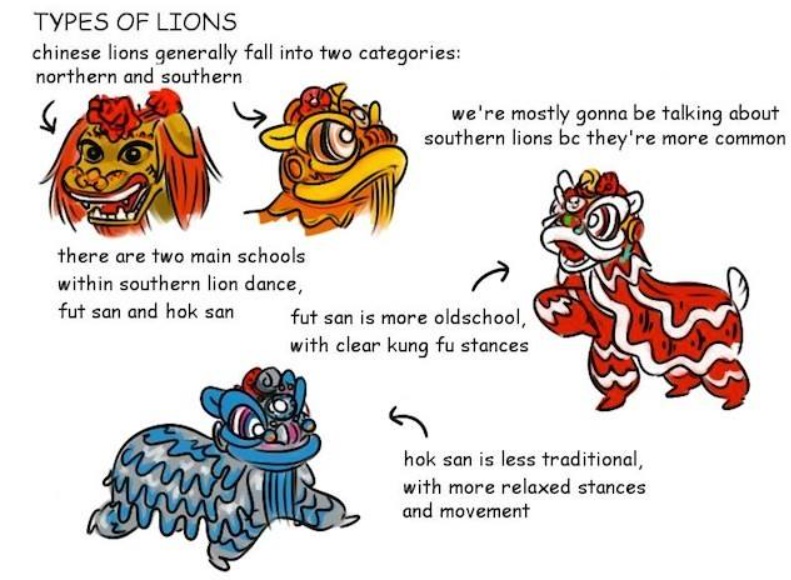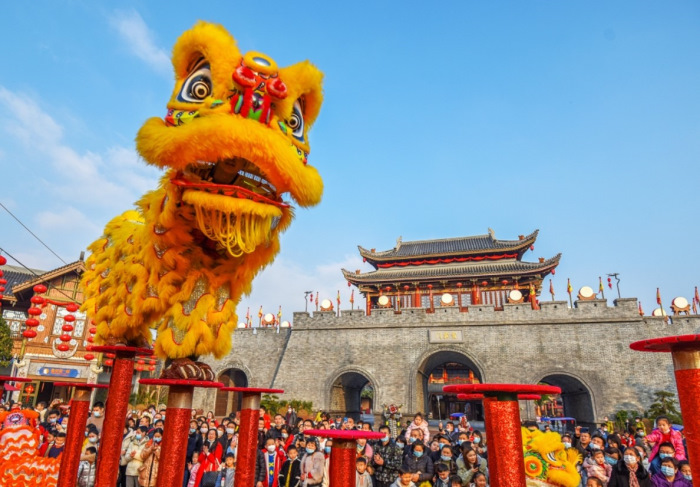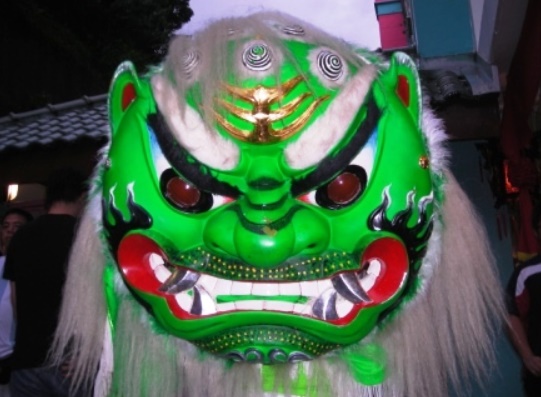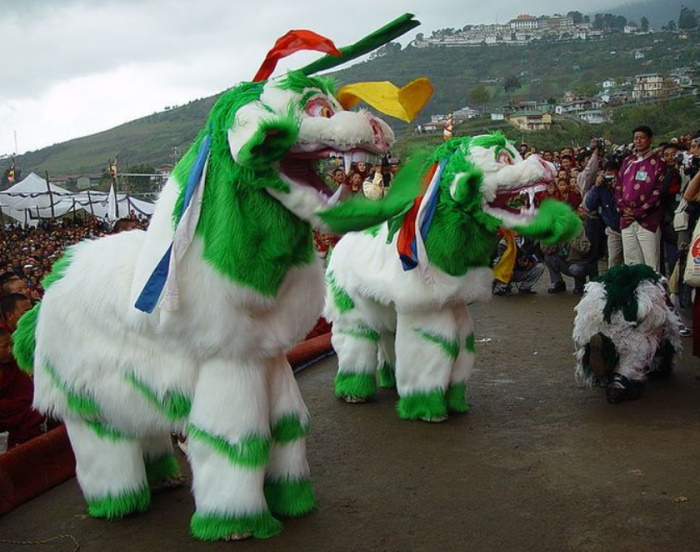The Lion dance is one of the oldest and most famous traditional dances in Asia that is still with us today.
During the Lunar New Year, Mid-Autumn Festival, wedding ceremonies, business launches, and other cultural or religious events, it is almost an indispensable part!
Are you curious about Lion dance facts such as its origins and meanings? We have it all covered!
Table of Contents
Lion Dance Origin & History
The oldest origin we can trace back to is a few decades before Tang Dynasty (618 – 907). Dancing while wearing masks of mythical creatures or mundane animals has always been an important trait of Asian culture in general.
One of the most well-known folklore told us about an emperor losing a batter and being rescued by a creature he had never seen before. After returning to his army and consulting the ministers, he learned that it was a lion.
Priceless resources of the Qin dynasty recorded ritual dances wherein dancers put on bearskin masks. Han dynasty also had historical texts about mime artists mimicking dragons, phoenixes, or fishes.
In these texts, they referred to these performances as Shujing.
However, no matter how many claims China makes about the Lion dance, the lion is not a Chinese native animal.
Logically, Chinese ascendants must have seen lions somewhere outside the country and used them as a symbol in the dance.
Chinese Lion Dance
The very beginning of the Lion dance during the Tang Dynasty, people called The Five-Direction Lion Dance or The Great Peace Music.
As the name might have disclosed, the performance included five lions with different emotions expressed through the mask. 2 artists will lead and control them on a rope, while 140 singers accompany them.
Another account described the lions as standing tall and proud at over 3 meters. Following each of the lions are twelve ‘lion lads’ using red whisks to tease the powerful creatures.
The last but not least popular version involved lion skins with wooden heads, furry bodies, silk tails, golden eyes, and silver teeth. The performers are non-Han folks from Central Asia.
As you can tell, it is extremely similar to the Lion dance we see in modern days.
In China, Northern and Southern are the main variations of the Lion dance, though they are not necessarily the only regional versions we get to see. How the lion looks also varies significantly across the places.
Check more: Famous Chinese traditional dances
Chinese Northern Lion
Between the two styles, the Northern Lion dance was created first, or at least most of the resources we have today agree with that fact.
Unlike any other set of lion dance headgears, the Northern style is typically performed with a male and a female lion. They usually have their faces painted golden.
The male lion might wear a red bow to match its red and yellow hair, while the female lion will have green hair or a green bow.
Chinese Northern Lion dance is popular for its stunts with acrobatics and balance tricks to capture the audience’s attention.
It is generally believed that the Southern style adopted a lot of spirits and vibes from it. And we are going to see if this is true in the next section.
Chinese Southern Lion
Compared to the Northern version, the Southern Lion developed a bit later, perhaps around the time of the Ming dynasty.
Its origin was Guangdong province, yet myths about how it started surround it like a thick fog.
A story spread among the people was the Lion Dance first acted as a celebration performance after a bunch of villagers succeeded in warding the Nian monster off.
Another story says the lion appeared in Emperor Qianlong’s dream while he was touring the south of China.
Amazed by how auspicious and aural the animal was, Qianlong demanded his servants to bring his vision to reality and incorporate it into festivals.

Hok San Style
Regarding contemporary styles, Hok San (or He Shan) is the most well-known.
It featured the headgear of the Southern lion and movements of the Northern dance. It is also the reason we know of the Lion dance as lively and energetic due to realistic stunts and movements.
The creator of Hok San is Feng Gengzhang, entitled the Lion King of Canton. He came from the He Shan county of Guangdong (hence the alternative name of this style) and practiced martial arts with his father’s instruction.
Gradually, Feng added feline moves to the Lion dance he was taught and came up with his own version of it.
After the modifications to the dance, Feng and the disciples also looked for a way to make the lion’s head more captivating.
Coupled with the unique footwork and rhythm, Hok San now has both visual and entertainment values. Hence, it became widely recognized and had an association in Singapore.
Hok San includes a trio of lions of different colors. Black Lion is the youngest, the next is the Golden Lion, and White Lion is the oldest.
The performers should be able to express these differences as accurately as what was described in The Romance of the Three Kingdoms, a classic novel focusing on three great friends who have sworn to be brothers and rebuilt the Han dynasty.
Sometimes, people associate the lions with personality traits such as courage, liveliness, and friendship, which are closely related to the novel characters mentioned above as well!
Fut San Style
For Kung Fu students, Fut San (or Fo Shan) is the style to go for, hence it varies tremendously from Hok San.
First of all, the lion used in this version is quite heavy compared to the common lion outfit, the hair is brittle, and the features (eyes, teeth, and tongue) can move along with the dance moves.
You can also notice exquisite details such as the diamond pattern on the tail or the bells attached to its body.
The modern Fut San has toned down remarkably with the lion skin, so the costume is not as heavy or prominent anymore.
However, due to the martial moves, it is still only recommended for advanced Kung Fu trainers.
Green Lion Style
Taiwan and Fujian people will be more familiar with the Green Lion dance. It is not too different from the quintessential Chinese Southern Lion dance, though the flat and round mask was one of a kind.
The pronunciation of Green Lion (青狮) is quite similar to that of the Qing Army (清师). People tend to believe it was part of the anti-Manchu spirits after the Ming dynasty fell.
In practice, trainees will target the lion skins equipped with blades and see them as models of the Manchu soldiers.
However, after an overly aggressive performance in 1912, the authorities decided to leave blades out of the stage and only use the dance for ritual or cultural means.
Lion Dance in Other Different Regions
Vietnamese Lion Dance
Vietnam is one of the countries that welcomed the importation of the Lion dance and exposed it to a lot of adaptations.
The origin
The Vietnamese legend of the Lion dance started from an old story that goes like this:
“Once upon a time, there was a monster sowing fear and causing ruckus for villagers every mid-August. A monk from far, far away passed by one day and decided to put an end to this madness.
He told the disciple with the large tummy to wear red clothes and hold the magical hand fan to chase the monster away, while other disciples made loud noises with brass instruments to scare it off.”
Therefore, the Lion dance is mainly performed on the most festive and traditionally important occasions as a sign of omens being eliminated and prayers for fortune.
Depending on the region and the season, Vietnamese people also enhance their performance with Unicorn and Dragon.
The Northern side still refers to it as the Lion dance, yet it is known as the Unicorn dance in the Southern side.
Check more: Famous Vietnamese traditional dances
Costumes & Props
The first form of Vietnamese Lion dance involves only two performers. One of them will put the lion’s head on, the other handles the tail.
The “skin” of the animal will become livelier than ever when they begin to dance.
For the second form, they mount the head part on a stick and treat it like a banner. Attached to the stick is a long red cloth inscribed with black ink, symbolizing the body.
Rather than a dance, this performance leans more toward acrobatic art with skilled stunts or dancers building a human tower. Martial students usually perform it.
In both of these forms, the performance is accompanied by drumbeats. Aside from the main dancers, other participants will carry flags of five colors or radiant paper lanterns while dancing to the accompaniment.
You will also find another mutual trademark between the two forms, which separates Vietnamese Lion dance from others: Mr. Dia (Ông Địa). The people here recognize him as an Earth deity of luck and household.
The Performance
The dance often starts from a spacious spot before moving down the streets. In colorful outfits, the performers will enter shops and houses, getting offerings from people.
For a more intricate show, the owners of the houses can hold their offerings high in the air with a stick. The dancers will form a tower and imitate the act of swallowing the gift.
On rare occasions, several teams can start a competition and attempt to get the award. The more handsome the reward, the harder it gets. However, the gifts are not the ultimate goal for the performers.
After all the entertainment they bring, the true purpose of the Lion Dance in Vietnam is to welcome a special day, entertain children, and show respect to the elderly.
Japanese Lion Dance
When the Lion dance traveled to Japan and adopted the name “shishi-mai”, it still retained the meaning of expelling bad signs by using the symbol of a sacred beast.
From the middle of the 8th century onward, Japanese shrines and temples witnessed regular performances of this dance.
Starting from the 14th century to the 17th century, various groups of entertainers from Ise Shrine went on a journey across the nation, showed people the Lion dance, and gave away talismans.
Researchers of our time believed this act contributed greatly to the popularity of the dance in Japan.
For accompanying instruments, the main sounds come from flutes and drums. When folk songs are involved, special instruments might join in too.
Styles
While each region of Japan added a sprinkle of its quintessence to the dance, we can still divide all the available versions into two main styles.
1. Gigaku shishimai
It is also known as the Kagura school of Shishimai. It is present all over the country, especially in the Western region.
If you see this dance in a New Year festival, it is likely to be Gigaku. They have small, medium, and big lions – it depends on how many people are going to take part in the performance.
With small lions, there is only one dancer controlling the headgear and using their body to mimic the lion’s body movements.
With medium and big lions, a dancer will swing the costume and an instrument artist will also join them under the lion puppet.
2. Furyu shishimai
This style is more common in Kanto and Tohoku, originating from the Imperial Court Guards’ dance and the Drum dance from western Japan.
Nevertheless, an older theory states that Furyu shishimai derived from ancient dances of Japan, and the headgear referred to deers and wild boars originally.
Each performer will be responsible for one lion. The costume has a drum attached to its belly, and the dancers will tap this drum to accompany themselves.
In Tohoku, there are more performers included, though the most popular version contains three lions handled by groups of three. One of these lions is female, which is the reason for two male lions to fight.
Furthermore, Japan has plenty of derivatives from these two primary schools, each of them has signature details that help us memorize:
- Gyodo-jishi: The lion only leads the procession with slow movements, no dancing is required.
- Kinzo-shishi: A dance of tribute in the Tomisaki Fuchu town, celebrating god Kinzo’s victory against an evil lion and praying for safety.
- Ninindachi-shishi: Two people perform as the lion, accompanied by participants wearing goblin masks.
- Mukade-shishi: The lion has its body put through a bamboo ring while doing powerful and fun moves. Children will surround the lion and feign to battle with it using toy weapons.
Costumes
The headgear is the most elaborate part of the outfit. Wood is the main material for it, yet the traditional Japanese headgear consists of paper pieces put together.
In our time, styrene foam has become a good replacement too.
In general, the performers will adorn colorful outfits. We often spot the ones under the Lion dance costume wearing the same colors to create a pleasant visual effect.
Meanwhile, the participants standing outside will have something different though not more prominent.
Japanese people use the term ‘school’ to refer to a variation of a dance style. Hence, you don’t need to be surprised if you come across schools with a variety of outfits.
Korean Lion dance
The historical work of Korea, Samguk Sagi, recorded the Lion dance as “Sanye”. It is part of the poem collection about dances by Choe Chiwon.
An older origin points back to the 6th century because of a tune called “The Talent of the Lion”. Scholars believe that it refers to the Lion dance we are talking about.
To Korean people, the primary meaning of the Lion dance is not too different from its original version: expelling the bad spirits and wishing for the best of luck.
Styles
In modern Korea, two major forms of Lion dance have survived until today. Saja-noreum is a drama with exorcism as its purpose, and Sajach’um is deeply associated with masked dramas.
Usually, in these dramas, the lion served as one within a series of acts. The most popular dramas involving the Lion dance are T’ongyong Ogwangdae, Suyong Yayu, and Unyul t’alch’um.
Costumes
The start of the Korean Lion dance was during the reign of the Goryeo dynasty when the connection between Korea and China became tighter than ever.
In the well-known Bukcheong Lion dance, or Lion Mask Play – as it is more known, the head of the lion is gigantic yet comic rather than fierce.
Artisans will paint the lion’s eyes as a means to banish the devils. Paired with it are brown outfits and other masks.
In Gangnyeong and Pongsan, they make the eyes capable of rolling and attach bells to them, so the lion will produce ringing noises while moving, and the sounds will scare the evil spirits off.
Rumors had it that if children sit on this lion’s back, they will be blessed with health and thus live a long life void of illness.
Tibetan Lion Dance
Origins
Within Tibetan diaspora groups and Tibet itself, you will find the Lion dance under the name Senggeh Garcham.
It is also known as Singhi Chham in Bhutan, Nepal, India’s northwestern regions, and certain parts of Ladakh and Uttar Pradesh.
Senggeh is derived from Sinha, the Sanskrit word for Lion, and Cham is a ritual dance in Buddhism.
The Snow Lion Dance
The lion symbolized in this Tibetan variation of the Lion dance is a snow lion, the national emblem of Tibet.
It represents the glaciers and the mountains covered in snow in the country. Strength and power are prominently symbolized via the image of this white lion.
The more accessible version of the Tibetan Lion dance is the secular performance. When performed by bon-po monks, it is more appropriately recognized as a ritual dance.
You will also find the Snow Lion dance in various Himalayan regions such as Sikkim and Arunachal Pradesh.
Lion Dance Music
As we have mentioned above, Lion dance has a deep connection with beats. The primary instrument used in the performances is usually a drum, regardless of the country.
Gongs and cymbals might also be part of the band because they create rhythmic sounds, although the sounds can be vastly different from one another.
The evolution of technology allows us to play any music we like with smartphones, tablets, computers, or MP3 players.
Therefore, we no longer have to carry chunky instruments around, our lion dance music is always ready to play.
Lion Dance Competitions
Origins
Due to the waves of immigrants and diasporas from the countries that are deeply involved with the Lion dance, the influence of this significant cultural trait has spread all over the world.
Anywhere with a remarkable population of Chinese, Vietnamese, Japanese, or Korean people could become a new root for the dance to expand even more.
Originally part of martial arts, the Lion dance has evolved and adapted more sporty as well as artistic values.
The expression of the lion and the natural movements of the dancer were all considered. If they can incorporate acrobatic skills and elaborate styles, their performance will be appreciated even more.
For the Lion dance, this development led to true evolution. More modern variations were spawned, followed suit by competitions for the dancers to compete professionally.
International championships of the Lion Dance might have different host countries such as Malaysia, Taiwan, Hong Kong, or Singapore.
Props
The most common style in the contest is the Southern Lion, performed on a traditional jong set with 21 or 22 poles. The height ranges from 4 – 10 feet, yet it can go up to 20 – 26 feet in competitions.
In 1983, when Malaysia hosted the world championship, the first jongs were introduced as “Plum Blossom Poles” or “May Hua Poles”.
The set included 5 poles standing at a height of 33 inches and a width of 8 inches, made of wood. The bottom of each pole has an iron fitting for stability, while the top uses a piece of rubber for traction.
Afterward, they added 16 – 17 poles to the set. The height and the width increased tremendously, and the material was changed to iron as well.
Judgements
The first factor that will meet a judge’s eye is the liveliness of the lion. From there, they will observe the choreography and give each team the deserved scores.
Dance moves, stunts, and acrobatics are what they expect to see, of course at a high level of creativity and difficulty.
The live accompaniment of pulsating and rhythmic instruments is also essential if you want to fully convince the spectators along with the judges.
According to the International Dragon & Lion Dance Federation, the judging rubric has a 10-point base, which is also used in professional competitions.
Famous Competitions
Every two years, the Genting World & National Lion Dance Championship will take place in Malaysia, and the tradition has begun since the 1980s.
Another well-known competition also held in Malaysia is the Tang Long Imperial World Dragon & Lion Dance Championship.
In Singapore, there is also a competition named the Ngee Ann City National Lion Dance Championship, it is an annual event starting from the 90s.
By the beginning of the 21st century, the Dragon dance was included in these competitions, hence the teams practicing this style are also eligible as contestants.
FAQs
1. What Does It Mean When You Touch The Lion Dance Headgear?
According to dance masters, people who touch the lion’s head will receive luck and wisdom for the whole year.
Furthermore, touching the body has a similar effect, while touching the mouth means you won’t have to experience hunger.
They also warn people not to touch the tail since it might result in bad luck!
2. What Is The Meaning Of The Lion Dance At Weddings?
With colorful clothes and powerful movements, the Lion dance is bound to lift the mood and spread excitement everywhere it goes, hence it is seen as a symbol of fortune and blessing.
People believe it will also ward off any evil spirits nearby, which might give the newlyweds a good start.
3. What Is The Difference Between The Dragon Dance And The Lion Dance?
People often equate the Dragon dance and the Lion dance because the appearances are extremely similar and the meaning is almost the same too.
Nonetheless, there is a distinction between them.
You will need only two dancers to handle the Lion costume for the performance, while the number for the Dragon dance is at least three and possibly more than ten. It’s because the Dragon skin tends to have an extremely long tail.
Final Words
The Lion dance is unarguably a prominent trait when we talk about Asian cultures. Through the depressing eras of being criticized and suspended, it found a way to come back and shine more brightly than ever.
If you have an opportunity to visit an Asian country or a Western region infused with Asian history, you wouldn’t want to miss out on this energetic and joyful dance!





